Cold blood does not warm.
For those who are unable to maintain their body temperature, in winter there is only one thing left to do - freeze, fall asleep, become numb, in order to wait out unfavorable living conditions. All cold-blooded animals do this: mollusks, crustaceans, spiders, insects, fish, amphibians and reptiles. When winter comes, they go into hibernation, called cold torpor. The most they can do is to provide a shelter where the temperature does not drop below 0 °C. otherwise, tissue cells are irreversibly damaged by ice crystals formed during freezing. Crayfish, completely unaware of the violent reaction their peaceful winter rookeries evoke in people, burrow into the silt at the bottom of reservoirs. Males usually overwinter in groups in deep holes at the bottom, while females spend the winter alone in burrows. True, this cannot be called loneliness, because females glue from 50 to 500 fertilized eggs to their short legs, from which crustaceans the size of ants hatch in early summer. If the silt freezes, the crayfish do not die and come to life when it thaws. They are not afraid of a long stay without water, gradually replacing it in their gills with air with a characteristic sound (this is why they say that crayfish taken out of the water whisper, as if saying goodbye to each other). Pond snails spend the winter there in the mud. Land snails, after accumulating the necessary nutrients, dig holes where several winterers at once could “take a nap” together deep underground at a temperature of 7–8 °C. Having well sealed the shelter, they descend to the bottom and lie with the opening of the shell upward, which, however, is also covered with a mucous substance. When the weather gets colder, the snails burrow even deeper, forming new films and air chambers that act as an excellent insulator. All metabolic processes abruptly, within a month, die out in order to reach the minimum at which the animal falls almost into a state of suspended animation with barely perceptible vital functions. and so on from October to early April.
The onset of the winter season finds insects at different stages of their development: in the form of eggs, larvae, pupae or as adults. Each species has developed its own approach - at what stage it is better to “sleep off”. For example, ladybug and the malaria mosquito overwinter only as adults, and aphids - in eggshells. But there are also those for whom any form of hibernation is good. For example, house flies - they overwinter in the form of larvae, and in the form of pupae (in warm dung heaps), and in the adult state. The duration of sleep also varies: the peacock butterfly remains in a state of suspended animation for five and a half months at a temperature of about 6 °C, and the silkworm needs a month more at 8.6 °C.
Even with the appearance of the first signs of cold weather, insects find comfortable shelters under stones, tree bark, fallen leaves, and in the soil, where after snowfall a moderately low and uniform temperature remains. At 0 °C, their metabolism slows down significantly: respiration is suppressed, the rate of oxidative processes decreases by 10–15 times. To survive this, wintering is preceded by certain preparations: fat reserves are accumulated (they reach 18% of body weight), the body is dehydrated as much as possible (in the Galica larva, the water content drops from 65 to 20%). Some species of insects can tolerate very low temperatures, such as meadow moth caterpillars, which retain the spark of life down to minus 30 °C! But this is rather an exception, and not everyone can do this. Bees, for example, do not hibernate for a long time; the reserve of accumulated fat does not exceed 1.5–2%. But still, at temperatures from 0 to 6 °C they become numb and can remain in this state for 7–8 days. At lower temperatures they die. Unfortunately for many lower animals, nature has not provided them with a tracking mechanism, and if the choice of wintering place is unsuccessful, torpor often develops into its logical continuation.
Oddities of black fish.
Some species of fish react in a unique way to a sudden drop in water temperature - they fall into a state of shock. After a short phase of excitement, they stop breathing, swim and look as if they were dead. It is enough, however, for the water to warm up, and they quickly come to life. Cooling turned out to be detrimental to the fish, leading to the formation of ice crystals in the blood and tissues, damaging the walls of blood vessels. They can return to life only if the freezing extended only to the superficial tissues. At the same time, the fish lives for some time due to oxygen reserves in the swim bladder (the assumption that frozen fish breathe through gills turned out to be unfounded).
One of the fish most adapted to cold, the so-called black fish, lives in rivers, lakes and peat bogs of Chukotka and Alaska. The harsh climate allows it to revive only for a short time summer period, which she uses for reproduction. The rest of the year, the fish burrow and freeze into the mud. If the temperature of the fluids in the body does not fall below - 0.3 °C, then with slow defrosting they come to life. If the blood freezes, the fish die. The local population uses this fish as dog food. They say that if a dog swallows frozen fish whole, then soon after that it will defrost in the stomach and begin to greatly irritate its walls. in such cases, the dog usually regurgitates the fish, and if it falls into the water, it immediately swims away calmly.
Of the freshwater fish, carp, ruffe, perch, catfish and others go into hibernation back in November. When the water temperature drops below 8-10 °C, these fish move to deeper parts of the reservoir, into the so-called wintering pits, bury themselves in large groups in the mud and remain in a state of torpor throughout the winter. At this time, the carp's heartbeat slows down from the normal 25–30 beats per minute to 2–3, and breathing to 3–4 breaths per minute. Sturgeon, sterlet and beluga have an interesting adaptation - when severe cold occurs, their body is enveloped in mucus, which protects them from the adverse effects of the environment, and they hibernate. Some species of herbivorous fish (grass carp, silver carp) also overwinter in groups, covered with a thick layer of mucus. Some marine fish also tolerate extreme cold in a sleepy state. Already in the fall, herring approaches the coast of the Arctic Ocean to fall asleep at the bottom of some small bay. Even the Black Sea anchovy moves to the southern regions - the shores of Georgia and the neighboring coast of Asia Minor, at this time the fish is weakly active and does not eat food.
Salamander from eternal ice.
Amphibians prepare for winter in advance, accumulating reserves of nutrients in the summer. And in the fall, when the daytime temperature drops to 8-12 °C, and the night temperature to 3-5 °C, they go to their future wintering sites, sometimes covering several kilometers. One part of them winters under water, the other on land. Lake frogs, grass frogs, quick frogs, and long-legged frogs hibernate under water. They gather in groups of 10–20 pieces (sometimes up to 100) of different sexes and ages, and sometimes of different species, and burrow into silt or underwater depressions. With such a group wintering, the metabolic level of frogs is almost 40% lower than that of those wintering alone. During hibernation, frogs breathe only through the skin, the pulse slows down, but still, although extremely slowly, amphibians grow and their reproductive cells mature. Moreover, their sleep is shallow, and under unfavorable conditions they can move to another place in the same body of water. The main thing is that this happens on time, because the most significant danger for them lies in the lack of oxygen. During very severe winters, even mass deaths of amphibians occur, especially when the reservoirs in which they winter freeze to the very bottom. Therefore, they prefer fast-flowing rivers and streams, channels, canals and lakes with rivers flowing into them, that is, they choose reservoirs rich in oxygen. During hibernation, amphibians sharply increase the diameter of the blood vessels in the skin through which they breathe.
The green and gray toad, common tree frog, spadefoot toad, yellow-bellied toad, and salamanders spend the winter on land. They winter in large groups at the foot of cliffs, in rock crevices and between tree roots, in burrows dug by other animals, under a thick layer of leaves and moss. Some species are even capable of burrowing into the ground.
Tritons different types They winter both on land and under water. The first usually settle under rotten stumps and trunks of fallen trees, and if they do not find such comfortable apartments, they are satisfied with cracks in the soil. Of particular interest are Siberian newts - salamanders that live in a vast territory from Kamchatka and Sakhalin to the Urals. It is the only tailed amphibian north of the Arctic Circle. Even at 0 °C it can still move, and some individual specimens of the salamander tolerate cooling (naturally, in a state of torpor) down to -37 °C. Geologists and builders have found newts frozen into excavated ice blocks. It often happened that newts that had thawed and were released into heated water came to life and ate the food offered to them - flies, spiders, aquarium fish. in 1956, a mining team in the Magadan region found a newt at a depth of 14 meters. When we returned to the tent and lit the stove, the frozen animal gradually thawed and began to move. His life lasted for 12 hours. At the same time, they hastened to declare this event a great sensation: a fossil newt was allegedly found, which, after being in a state of suspended animation for two million years, came to life again. In fact, the newt turned out to be not a fossil, but a modern one. But the question of how long the life of frozen amphibians can be preserved remains a matter of debate. Found another time in Chukotka in a piece eternal ice The Siberian salamander was subjected to radioisotope research. Kyiv scientists came to the conclusion that its age ranges from 75 to 105 years, while the control amphibians turned out to be many times younger.
Almost all species of reptiles in northern latitudes hibernate in winter. in the northernmost regions it lasts 7–8 months. To the south their hibernation is shorter. Lizards burrow into the soil, making burrows on steep, dry slopes that are not threatened by flooding. on a good sunny day they wake up for several hours to bask in the sun and hunt and then hide again, falling into a stupor. Land turtles climb half a meter deep into the soil, into natural shelters or burrows of moles, foxes, rodents, covering themselves with peat, moss and wet leaves. It happens that they wake up sometimes for a whole week. Swamp turtles spend the winter buried in the mud of ponds. Snakes don't like the cold. Even in the summer, if you put a snake in the refrigerator for a few hours, it can be treated like a piece of rope. Therefore, snakes select their winter quarters carefully and choose them for a long time. These are usually underground caves and voids formed around large old stumps with rotten roots, or crevices in rocks. a large number of snakes even gather in such shelters various types, forming huge balls. they sometimes contain from several dozen to hundreds of snakes, which has led to the erroneous belief that snakes gather in balls to keep warm. Meanwhile, the temperature of snakes during hibernation is almost no different from the ambient temperature, and they gather together simply due to the lack of suitable shelters - some “dormitories” have been used for decades.
How do animals manage to remain viable while frozen? Just as when cold weather sets in, antifreeze is added to the radiator of cars, freezing at minus 37 ° C, antifreeze proteins are formed in the body fluids of some cold-blooded animals in winter, which, when ice crystals appear in the body, bind to them and block further crystallization of water. In many fish and terrestrial arthropods, including spiders and ticks, the effectiveness of antifreeze proteins is so great that it prevents the formation of ice even at minus 15 °C. In addition to special proteins, the bodies of some cold-blooded creatures also produce antifreeze carbohydrates, which further reduce the point of maximum hypothermia. For example, in the tissues of many insects in winter, the antifreeze carbohydrate glycerol accumulates, which successfully prevents freezing. In the caterpillars of the gall-forming butterfly, by mid-winter glycerol makes up 19% of the entire body, allowing hypothermia to minus 30 °C. And the hairy caterpillars of the Arctic butterfly spend up to 10 months a year in a frozen state at minus 50 °C or more! Originally adapt to low temperatures water of some fish living in the North Atlantic Ocean and in Arctic waters - they change the composition of the blood. as the water temperature drops in the fall, salts accumulate in their blood in such a concentration as is typical for sea water, which enhances the cryoprotective effect, making it difficult for the blood to freeze. Relatively recently, special antifreeze proteins were discovered in the blood of these fish, which lower the freezing point of the solution to an even greater extent than salts.
If a very harsh winter is ahead, then in the fall, in cold-blooded animals (especially insects), before the first frost, cryogenic protectors that protect against ice accumulate in the body, which increase the strength of cell membranes and prevent the so-called osmotic stress, when water from the cells tends to leak into the extracellular environment with ice , reducing the volume of cells and making them vulnerable to ice crystals piercing the shriveled cell membranes. Cryoprotectors also serve as metabolic slowers. in a frog, for example, as soon as ice begins to form on the surface of the skin, the cryoprotector glucose is rapidly synthesized from animal liver starch. as a result, after eight hours, all organs are saturated with it, metabolism slows down to a minimum, and energy consumption is limited. The record for this type of use of cryoprotectors belongs to turtles - their metabolism drops to a level that ensures survival without oxygen consumption (!) throughout the winter. Moreover, at high concentrations of glucose in the body, there are no phenomena inherent in a person with high levels of glucose in the blood - diabetes and aging. The frost resistance of cold-blooded animals has always aroused the keen interest of scientists.
Some species of higher plants also enter an anabiotic state. The record in this regard belongs to the bronze plant, found in the prairies of the American continent. Placed in a herbarium, this plant survived for 11 years in a dried state without losing its viability. The question inevitably arises: what helps plants tolerate severe dehydration and fall into a state of suspended animation, in which metabolism proceeds so slowly that it is practically almost zero? According to scientists, during dehydration in plants that are capable of falling into an anabiotic state, the respiration process is not disrupted, which retains its so-called energy value. When plants become dehydrated, they continue to produce energy-rich compounds such as ATP (adenosine triphosphate). The energy generated during the process of respiration until almost complete drying of these plants is transferred to almost all cellular structures and all cellular contents, which, when dehydrated, turn into a jelly-like state, and the cells can maintain their viability for years.
| |
Direct educational activities
compensatory group for children with special needs (senior)
teacher-speech therapist Oragvelidze I.V.
Insects. Amphibians, Reptiles.
Program tasks
- expand children's knowledge and ideas about appearance, habitat and way of life of insects, reptiles and amphibians;
- consolidate the ability to use possessive adjectives in speech;
- practice agreeing adjectives and numerals with nouns;
- learn to make sentences using supporting words.
Equipment: pictures depicting Ivan Tsarevich, insects, amphibians, reptiles, a toy “frog”, an arrow, an envelope with a letter from a frog, a strip of water.
1. Organizational moment.
Hello children. Today Ivan the Tsarevich came to visit us. His father ordered him to get married, and he wants to ask you for help. (a picture with Ivan the Tsarevich is put on the board)
Ivan the Tsarevich says that he wants to marry the frog princess, but is afraid to shoot into the swamp. Suddenly some old toad or turtle finds his arrow and asks him to help. Shall we help him guys? Ivan Tsarevich gave me this arrow and asked me to take it to the frog princess. And he will go after us, see the bride and take her to the palace. Can we handle it?
Yes! (children take the arrow from Ivan Tsarevich)
2. Subject message.
Before the trip, guys, we need to remember who amphibians and reptiles and insects are, there are a lot of them in the swamp, how they are similar and how they differ, where they live, what they eat (says the speech therapist)
Children name the animals and talk about them:
“Amphibians and reptiles can live both in water and on land. Many of them feed on insects and spiders. Some reptiles are predators (crocodile and snake, aquatic turtles). Many feed on plants. Reptiles lay eggs, from which young emerge, and amphibians spawn in water.
Insects have six legs. Their bodies are covered with a hard shell called the exoskeleton. The body of each insect can be divided into three parts: head, thorax and abdomen. Most insects can fly. They usually have two pairs of wings. Only flies have one pair of wings.
The bright coloring of many insects warns other animals that they are inedible. Many insects use color to hide from enemies.
3. Formation of possessive adjectives, nouns with diminutive and augmentative suffixes.
Guys, in order to get to the swamps where amphibians, reptiles and insects live, we need to turn into these animals. This way we can pass through the swamps undetected and find the frog princess.
The one who answers my question correctly can transform.
What is the name of the small lizard? Lizard
What is the name of the huge salamander? Salamander
Whose portrait is this? (speech therapist points to the crocodile) Crocodile.
What should we call the little newt? Newt.
What do we call a huge toad? Toad.
Whose portrait is this? Turtle.
What is the name of the small snake? Snake.
Whose portrait is this? Frogish.
What should we call the little mosquito? Mosquito.
A nest of wasps, whose nest? Osinoye
It flutters over the flower, dances, and waves its patterned fan. Butterfly
He flies all day long, does everyone get bored? Fly
A jumping champion, galloping, galloping across the meadows. Grasshopper
If I'm spinning in the air, I'll have a blast. Bug.
4. Psycho-gymnastics.
Now, guys, we need to get to the swamps, where the frog princess lives. Now we dive into the river and emerge in the forest, where there are many swamps. At the same time, we need to depict the habits of these animals so that the inhabitants of the swamps do not get scared of us and run away, but mistake us for their own. (children depict how a snake and turtle crawl, a frog and toad jump, newts and salamanders swim, a lizard runs)
5. .Formation of complex words
Well, guys, we have arrived in those places where reptiles and amphibians and insects live. You see, they surrounded us on all sides and asked who we were. We must answer correctly, otherwise they will understand that we are actually children from kindergarten, not animals.
Lizard, you have a long tail, so what are you? Long-tailed.
And you, Crocodile, have thick skin, so what are you like? Thick-skinned.
And you, toad, live both in water and on land, so what are you? Amphibian.
And you, frog, love to eat insects. What are you? Insectivore.
And you, turtle, eat grass. So what are you? Herbivore.
And you, newt, cold blood. So what are you like? Cold-blooded.
And if some object looks like you, snake. What is he like? Serpentine.
Salamander, and people have warm blood. What are they? Warm-blooded.
Well done guys, everyone answered correctly. Amphibians and reptiles recognized us as their relatives. And now they ask why we came to their forest?
6. .Selection of epithets.
We want to find the frog princess.
What is she like?
Beautiful, slippery, pop-eyed, smart, mysterious, magical, brave,
fearless, cute, small, tiny (children's answers)
Olga Kokovina
Ecological conversation on the topic “Where do fish, amphibians, reptiles and insects disappear in winter”
Tasks:
1. Formation in children of an idea about the life of fish, amphibians, reptiles and insects, their adaptability to seasonal conditions.
2. Teach children to establish cause-and-effect relationships of various types and to make their judgments with evidence.
3. Develop in children the ability to put forward hypotheses and draw conclusions.
4. Foster cognitive interest in nature.
Material: Why doll, story "Where frogs spend the winter" « Ecology in pictures» .
Progress of the conversation.
Pochemuchka greets the guys and tells them that he went for a walk to the lake. It was a wonderful winter day, snow was falling, but it was gloomy on the lake. I didn't see any
frogs, no mosquitoes, no flies. The lake was covered with ice and it was very boring. AND Where have all the insects disappeared?, frogs, fish.
Educator: Guys, do you want to know where did the fish go?, amphibians, reptiles and insects?
Listen, I'll read you a story "Where the animals spend the winter" from the book « Ecology in pictures» .
Questions: -How do frogs winter?
Why can't they live winter on earth?
That's right, frogs go underwater and spend the winter there, burying themselves in mud or silt.
Why: Guys, what will happen to the frog if you dig it out from under the snow and bring it close to the fire?
(she will die from rapid temperature change)
What do frogs eat in winter(they don't eat anything, they sleep)
And if the frog was covered with fur, could it stay through the winter? (a frog cannot have fur, it will overheat).
Could the frog be fluffy? (no, frogs breathe through the entire surface of their skin; in order for a frog to breathe, the skin must always be moist)
Why: I learned everything about frogs, thanks, guys. A where did the insects go??
Educator: Displays pictures of butterflies, beetles, and dragonflies.
Where do butterflies spend the winter? (fly to the south - cabbages, admirals of thistles) most die before winter, but the females leave behind clutches of eggs from which caterpillars emerge.
There are also butterflies that do not die, but fall into torpor. These are urticaria, lemongrass, mourning grass. In late autumn, these butterflies climb under fallen leaves, cracks in the roots of old stumps, under the bark of trees and other secluded places.
How do beetles spend the winter? (they sleep in a daze in various shelters - under the bark of stumps, in cracks in tree trunks, in the thickness of wood, etc.)
Where do dragonflies spend the winter? (most dragonflies die after laying eggs in water). There are several types of dragonflies (watchmen, large rocker) who fly south.
Why: I realized, guys, that the majority insects fall into torpor, stop feeding, and spend the winter in a state of hidden life. Where do they spend the winter? fish? (most go into deep winter hibernation)
Who helps the fish survive the winter? (fishermen who make holes cut ice holes)
Why do fish need these windows? (so they can breathe)
Why: -A where did the lizards go?, snakes, vipers? Like fish, their body temperature drops to ambient temperature during the cold season. They all hide in various shelters and fall into a stupor there. Lizards climb into cracks in the soil or crevices between stones and rocks. Snakes and vipers crawl into empty rodent holes. Swamp turtles go into the water and spend the winter there, burying themselves in mud or mud.
Educator: Well done! You explained everything very correctly to Pochemuchka. And now I invite you to play.
Didactic game « Insect or amphibian» .
The teacher calls insects and amphibians, children divide them into appropriate groups. At the end they call it a mosquito (This amphibian insect)
Didactic game "What does an animal do"(the teacher names the animal, the children say that it can do: fly, jump, run, crawl, swim).
Knowledge of the world.
Subject: Amphibians, reptiles, their varieties. Animals.Who is welcoming spring?
Goals: 1. Teach students to distinguish animals by external features. Classify them into animals, birds, fish, insects. Introduce animal life in spring.2. Develop students’ oral speech, observation, thinking, memory, attention 3. Foster a love for animals living in forests and zoos, a love for nature native land, positive attitude towards learning. Species educational activities: Personal - meaning formation, i.e. students’ establishment of a connection between the purpose of educational activity and its motive.Communication – mastery of monologue and dialogic forms of speech;
- the ability to express one’s thoughts with sufficient completeness and accuracy;
- the ability to listen and engage in dialogue, participate in collective discussion of problems, build cooperation with peers and adults.
Regulatory – organizing your educational activities;
Cognitive – conscious and voluntary construction of a speech utterance in oral form.
Progress of the lesson.
1.Org. moment. Creating an emotional mood. - Guys, look how nice it is outside! The trees have awakened from winter sleep. The sun is warming. I walked along the street and collected smiles: here is the smile of a baby , how good it is! Here is the smile of a postman - the pride of our region, here is the smile of a saleswoman - a very rare thing! This is the cheerful laughter of the guys - for me it’s just a treasure. -What mood are you in? Draw your mood.Divide into groups using multi-colored emoticons.
- After each task in the group, you must choose who will defend this task.
The snow is already melting, the streams are running.
There was a breath of spring through the window,
The nightingales will soon whistle
And the forest will be dressed in leaves!
What else has changed with the arrival of spring? Children: The day has become longer. - The first spring flowers appear. - Sap flow begins in the trees. - Birds appear. Teacher: That's right. Last time we invited birds to visit. 2. Setting the goal and topic of the lesson. - Today I suggest you go on a trip to the forest dwellers and see who is welcoming spring. Close your eyes and imagine that you are in the forest. We walk into the very thick of the forest, last year’s leaves rustle under our feet, the wind shakes the trees, and they knock with their branches as if they are welcoming us. We walk along the path, it was specially laid out for us. There is still snow. Here and there the blue eyes of snowdrops peek through. Every day there are more and more thawed patches in the forest, less and less snow. Every hour everything comes to life and rejoices in spring. This is where we will stop. Open your eyes. Look at the drawings of animals. On the board: table 1. Slide. 3. Explanation of new material. There are many species of animals on earth. Animals of different species are very different from each other. And animals of the same species are very similar. There are several groups of animals. Insects are animals that have six legs. Fish are aquatic inhabitants. Fins help them move. Birds are animals that fly. In addition to paws, they have wings. Birds are covered with feathers. Animals are animals. Their body is covered with fur. There are animals whose bodies are covered with dry scales. These are snakes, lizards, turtles. They crawl on the ground. Animals can also be divided into two large groups - wild and domestic. Wild animals live in the steppes, forests, and fields. Pets live next to a person and benefit him. Slide. -Name the animals that live in water. -Name the animals that live on the surface of the earth, in trees. - Where do pets live? - Where do wild animals live? U.: To whom we will go, the arrow will show us. D.: We are going to the bear. U.: At the end of March, bears wake up from hibernation. The bear was hungry and thin over the winter. And now he is dissatisfied and angry with the whole world. He is so angry that he can even attack a person. In general, the bear is an omnivore. What do you think omnivore means? D: So he eats everything. U.: Do you know what a bear eats? D.: Berries, honey. U.: Yes, he loves both honey and berries. A bear can eat grass, seedlings, roots and mushrooms. From animal food, he eats crayfish, fish, insects, birds and bird eggs. Sometimes the bear attacks cattle. At the end of winter, in February, in the most severe cold, female bears give birth to cubs. They are born blind. And they weigh only half a kilo. The babies warm themselves near their mother and suck milk. They stay like that until spring. And in the spring, the mother bear brings her cubs out of the den. She teaches the cubs to find food for themselves. What do bear cubs eat? D.: Young grass.- Insects. - Plant bulbs. U.: I wonder who we are learning about now? Who does the arrow point to? D.: Like a hedgehog U.: Hedgehogs wake up early in spring. During hibernation they quickly lose weight. In the spring, hedgehogs quickly feed on insects, grasshoppers, crickets, cockroaches, and various beetles. Hedgehogs also eat earthworms, bird eggs, and sometimes forest and field mice. Hedgehogs hatch their offspring in the spring. The female gives birth to 3 to 8 cubs. She prepares a nest well lined with grass for them. A hedgehog feeds her cubs with milk. When they stop sucking milk, the mother brings them earthworms and fallen fruits to the nest. Soon she begins to take the hedgehogs hunting. Guys, think about what the life of a bear and a hedgehog have in common? D: Both bears and hedgehogs hibernate. - They feed their young with milk. U.: Well done! How do you understand the expression “breed offspring”? D: So, animals give birth to babies. U.: Absolutely right. Now we will talk about protein. All day long she jumps from branch to branch, from the top of one tree to another. In late spring or early summer, the squirrel breeds offspring. She gives birth to 3 to 6 baby squirrels. Who knows what squirrels eat? D.: Nuts, mushrooms.- Berries. - Kidneys. - Acorns. U.: In apples and pears, the squirrel eats only the seeds and throws away the pulp. She is not averse to predation - she carries eggs of chicks from bird nests, and sometimes attacks an adult bird. What color is it? D.: Red in summer, gray-blue in winter. - There is even a sign. If the early squirrel is blue, there will be an early spring. U.: That's right. Do you know any other animal that changes color? D.: Hare. 4. Physical education minute. Slide.We'll take a little rest.
Let's stand up and take a deep breath.
Hands to the side, forward,
The bunny is waiting at the edge of the forest.
(Children perform the movements.)
The bunny was jumping under the bush,
He invited us to his home.
(They jump on one leg, then on the other and on both at once.)
Hands down, on the belt, up,
We are running away from everyone.
(Running in place.)
Let's run to class quickly.
We'll listen to the story there.
(Sit down at their desks.)
U.: The white hare changes the color of its fur depending on the time of year. In winter it is covered with white fur, and in summer its fur is a dirty red-brown color. Now take the cards. Children are given cards with text. (see appendix). Children read aloud. U.: In the spring, the hare breeds offspring. She gives birth to 4-5 bunnies. Guys, why does a mother hare run away from her babies and not feed them? D.: Probably because she doesn’t want the fox to find the rabbits in her tracks. Bunnies sit quietly and no one will notice them. U.: Well done, it really is. What helps bunnies survive? D.: The rabbits have a warm fur coat. - Hare's milk is very nutritious, and the little hares gorge themselves on it for several days at once. U.: That's right! What do bunnies eat when they grow up? D.: Grass, carrots, cabbage. - Roots, buds. - Clover, young shoots. U.: Wonderful! You know so much! All animals moult in the spring. They exchange their winter coat for summer coat. Guys, which animal even changes the color of its fur? D.: At the hare, at the squirrel. U.: Think about what other animals wake up in the spring? (If the children do not know the answer, they can guess from the pictures on the board). D: Lizards, frogs, snakes. U.: In the spring, with the awakening of insects, water frogs emerge from the silt, where they hibernated for a long time. A female frog spawns. She lays up to 4000 eggs. Snakes and lizards wake up after hibernation and crawl out to bask in the sun. Fish spawn. In spring, fishing is limited, and hunting of animals is prohibited altogether. Why do you think? D: Most animals give birth to their young at this time. If their parents are killed, then many of them will die, since they cannot yet get their own food. - And if people fish in the spring, they can catch one that has not yet laid eggs. This means that her cubs will die along with her. They will never be born. U.: That's right. 6. Consolidation. U.: Our journey ends. Close your eyes and remember everything we have learned. Table 2 on the board. Slide. U.: Look at the board. What did you notice? D.: A hedgehog and a bear do not change color. - The hare and squirrel do not hibernate. U.: Guys, let's remember everything we learned about these animals in class. Let's read it again. D.: (reading). Molting, hatching, hibernation, color change. - Animals molt in spring. Their fur changes. - Even the color of the squirrel and the hare changes. - Many animals give birth in the spring. - In the spring, after a long winter sleep, bears, hedgehogs, frogs, lizards, snakes, and fish wake up. U.: Wonderful! You remember everything. - And now, tasks. (Task 3). Slide.Creative task Imagine and come up with an image of an animal that does not exist. Assessment The teacher asks you to evaluate your knowledge using an assessment sheet.
Reflection
U.: What new did you learn today? D.: We learned what happens in the lives of animals in the spring. - That hunting for animals and catching fish is prohibited in the spring. U.: Today you worked very well. Well done! - What did you like most? - What was the most difficult? - Which task was the most interesting? -Evaluate your work using the “Tree of Success”Application.
Task 1. The snow has not yet melted in the field, but the hare is already giving birth to babies. They are born sighted, wearing warm fur coats. As soon as they are born, they already know how to run. Having eaten their mother's milk, they run away and hide under bushes and hummocks. They lie quietly - they don’t squeak. A day passes, then two, three. The hare is jumping all over the fields, she has long forgotten about them. And the bunnies are still lying there. They can’t run: the hawk will just notice or attack the fox’s trail. Finally, a hare runs past - someone else's hare. She fed her and ran on. This is how it is with the hares: they consider all the hares as common. Do you think it’s bad for the homeless bunnies? Not at all! They are warm: they have a fur coat. And the hare's milk is so sweet and thick that the little hare pumps once and then is full for several days. And on the eighth or ninth day, the bunnies will begin to eat grass.Task 2. 1.Look at the picture. Name the animals. 2.Name and show the body parts of a bear and a hedgehog. 3. Compare a bear and a hedgehog: how are they different? How are they similar?
Task 3. Fill in the missing words. A brown bear and a hedgehog live in…. The bear's body is covered...brown.... The hedgehog's body is covered...... The bear eats...,...,... Loves.... Hedgehog feeds on insects,...,..., vipers. Words for reference: forest, thick, wool, prickly needles, grass, berries, nuts, honey, mice, worms.
Task 4. Find the extra word. Hedgehog, goat, bear. Goat, sheep, hedgehog.
MOLTING
WINTER
Hibernation
CONCLUSION
offspringchange coloring
HARE lizard SQUIRREL baby squirrels
FOX cubs
Mother bear cubs
WOLF wolf cubs
Bunny bunnies
HEDGEHOG hedgehogs
FISH
FROG
SNAKE
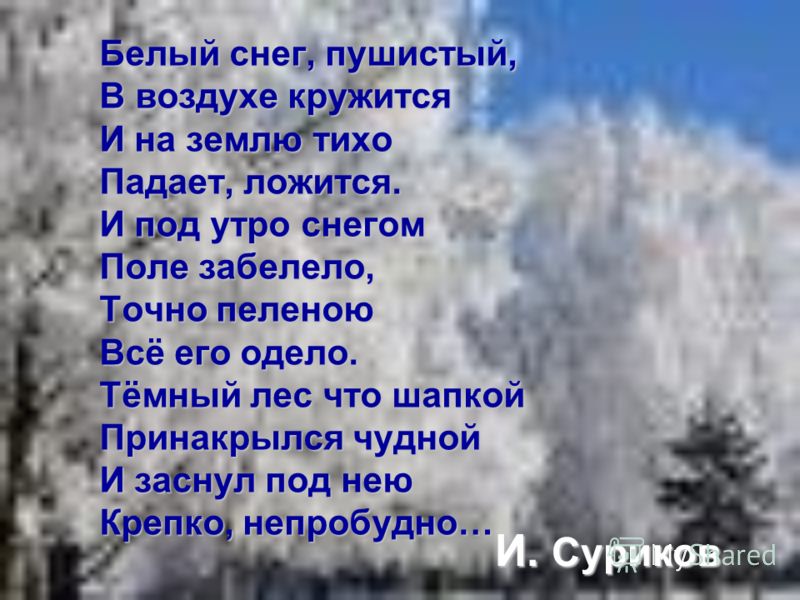
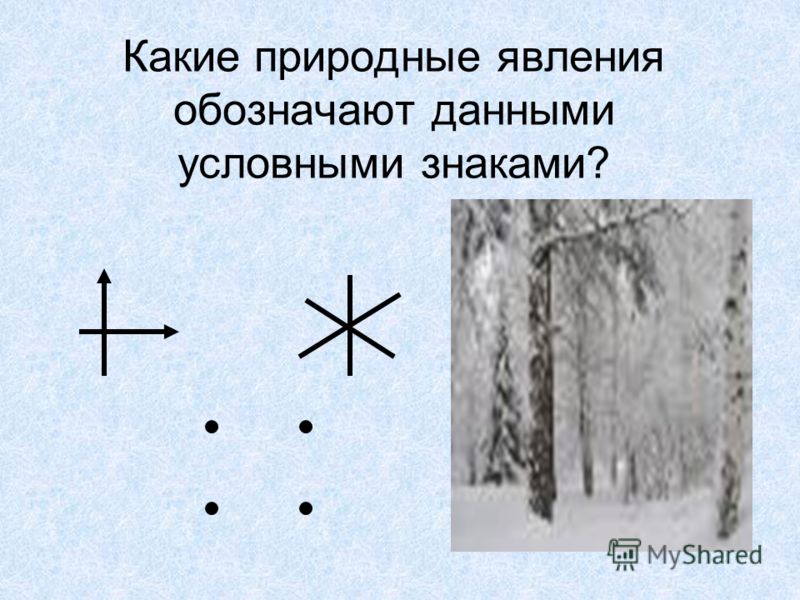

Indicate the stages of winter. It's a very cold time. Time for “pre-terpi- dary spring”. W h i t h T r o p Time. From February 2, 1 to March 2, 0. From January 21st to February 20th. From 2 1 December to 2 0 January. Root winter. First winter. The turning point of winter. winter.
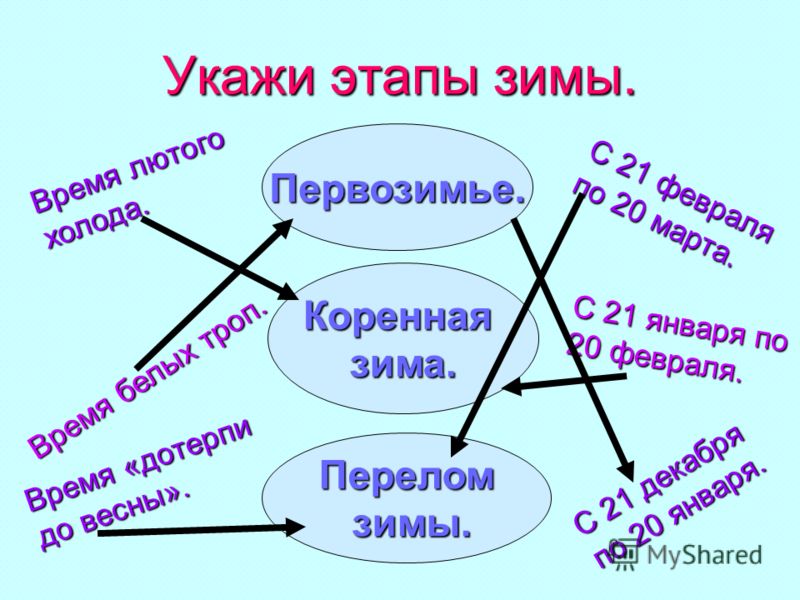
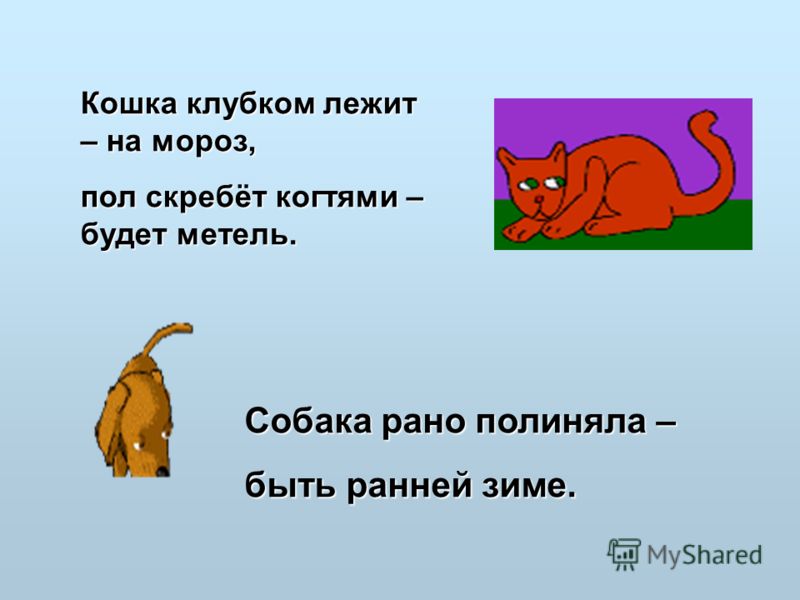
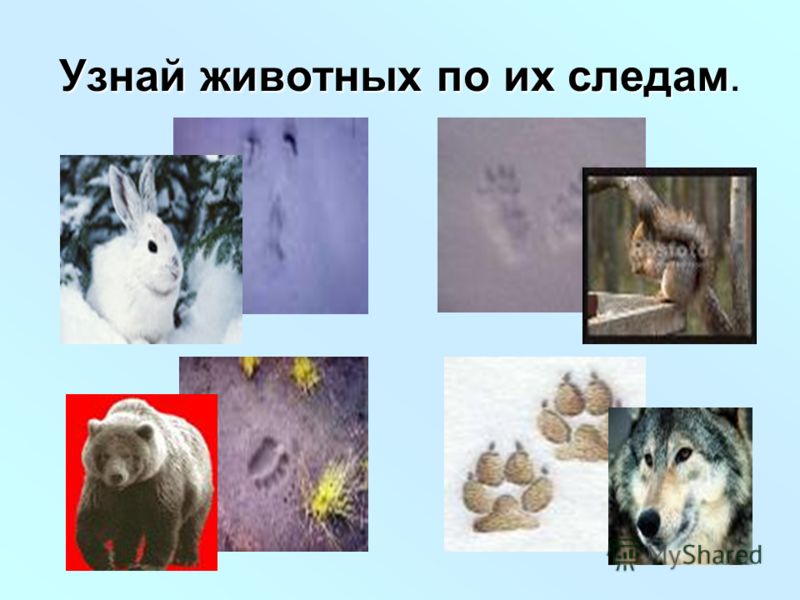
Insert words. Animals winter in different ways. Insects, amphibians, and reptiles that have cold blood ____________ for the winter. Some animals take refuge in their _______ and __________ until spring. Other animals exchange their summer ________ for winter ones and run all winter to avoid freezing. But ______ have especially hot blood; they never hibernate. bird fur freezes in burrows and dens
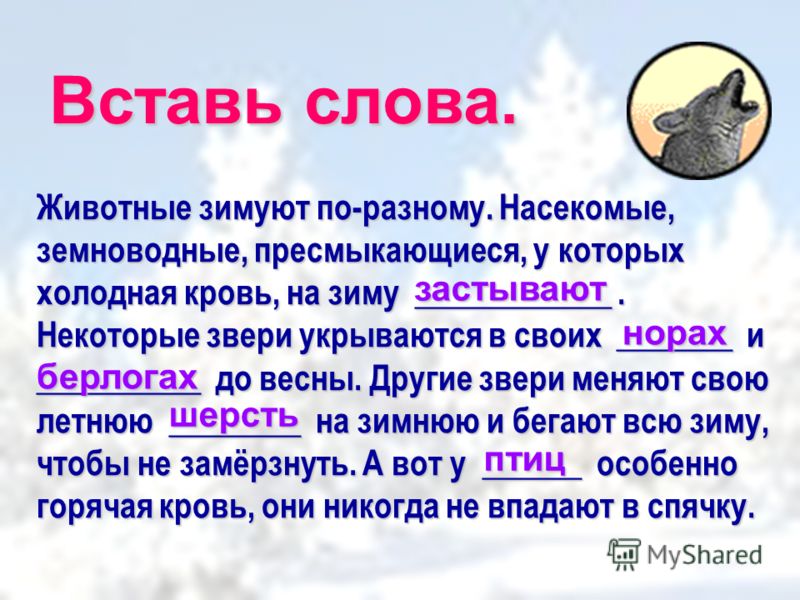
Guess the keyword. 1 R 6 B 24 B 7 C 3 R B YA AK K A 5 1. Who lives for six months without lunch? 2. What animal sleeps for nine months of the year? 3. Who changes their fur coat twice a year? 4. What does moose lose every winter? 5. Which bird has a snowdrift - both a bedroom and a dining room? 6. Who has a “wood” warehouse under the ice? 7. On which tree does the crossbill build its nest in winter? A R S U O N L K O G Y B C H I O B R E L
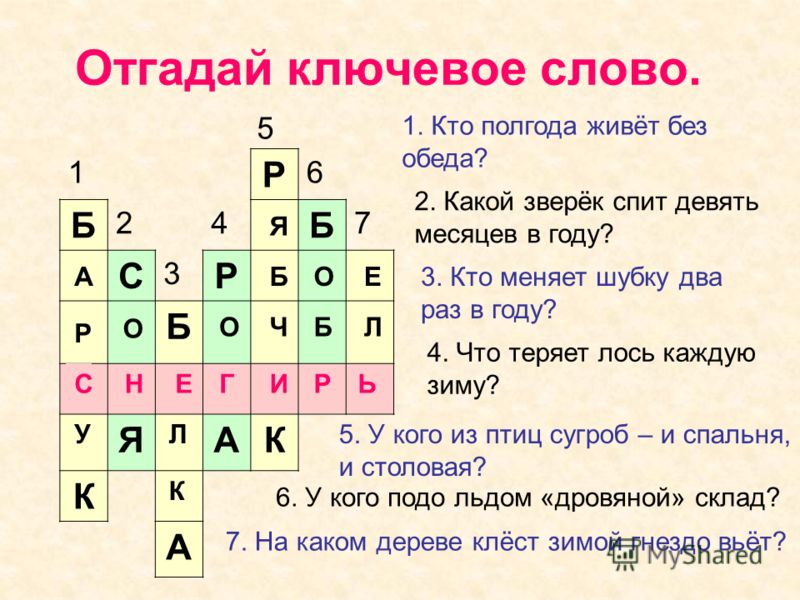
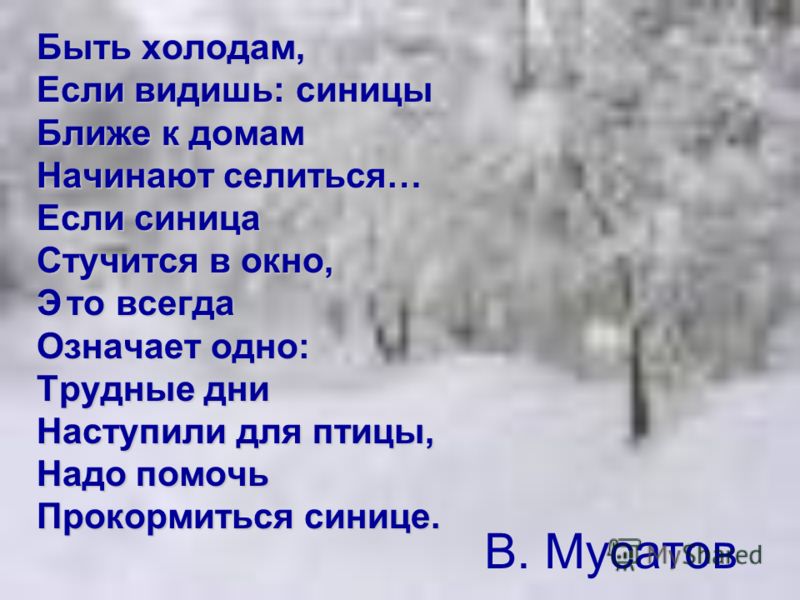
Solve the puzzle. The guys went to the grove and took with them food for the birds: pumpkin seeds, dried rowan berries, a piece of lard and a large cracker. At the edge of the forest they saw flocks of tits and bullfinches, a waxwing and a crow. Think about how the guys divided the treats. Keep in mind: crackers are too heavy for the tit, bullfinches don’t like lard, waxwings love rowan, and the crow is ready to profit from everything.



